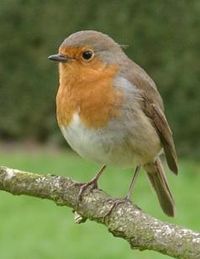|
Erithacus |

European Robin
|
|
Scientific classification |
|
|
| Species |
E. rubecula
E. akahige
E. komadori |
Erithacus is a genus of small
passerine
birds formerly classed as members of the
thrush family, but now considered to be
Old World flycatchers.
The three species are:
-
European Robin, Erithacus rubecula
-
Japanese Robin, Erithacus akahige
-
Ryukyu Robin, Erithacus komadori
The two Asian species were formerly considered to be
members of the genus Luscinia; apparently, both genera need
to be split and rearranged. The European species would then
be the only remaining Erithacus, whereas the East Asian
species are closely related to some species from the region
now classed as Luscinia, for example the Siberian Blue Robin and would form a new genus (Seki,
2006).
The three species are stocky small birds with an upright
stance and short frequently cocked tail. They have a plain
brown back, and a red or black face and breast contrasting
with whitish or grey underparts. The females of the Asian
species are much duller than the males, but in the European
Robin differences between the sexes are minimal and
restricted to the shape of the boundary between the red and
brown plumage on the forehead.
Erithacus robins are territorial woodland birds
which build a neat cup nest in a hole or on the ground. They
watch for insects, worms and other invertebrates from a low perch, and feed
mostly on the ground, hopping on strong legs with frequent
stops.
References
- Seki, Shin-Ichi (2006): The origin of the
East Asian Erithacus robin, Erithacus komadori,
inferred from cytochrome b sequence data.
Molecular Phylogenetics and Evolution 39(3):
899–905.
DOI:10.1016/j.ympev.2006.01.028
- Svensson, Lars; Zetterström, Dan; Mullarney,
Killian & Grant, P. J. (1999): Collins bird guide.
Harper & Collins, London.
ISBN 0-00-219728-6




